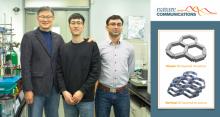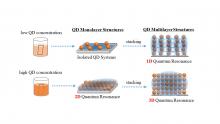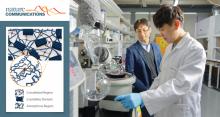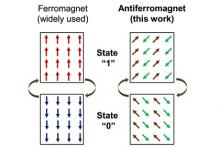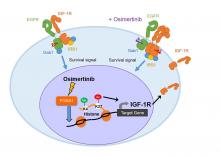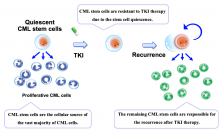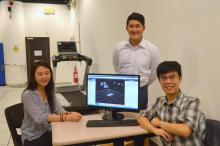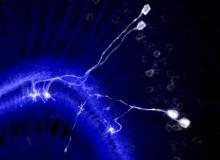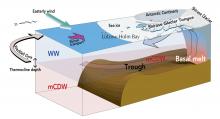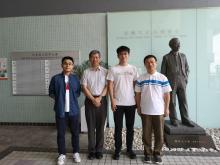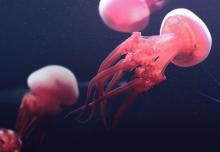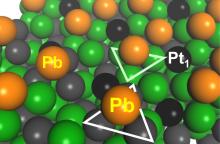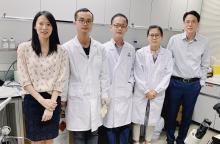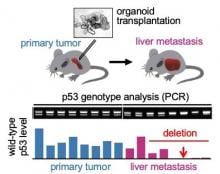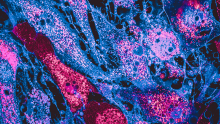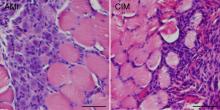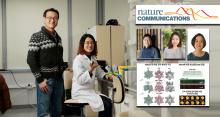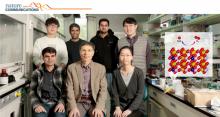Nature Communications
News
20 Nov 2020
A research team, affiliated with South Korea's Ulsan National Institute of Science and Technology (UNIST) has recently reported a significant discovery that could bring solar hydrogen production a step closer to reality.
20 Nov 2020
A research team, affiliated with South Korea's Ulsan National Institute of Science and Technology (UNIST) has developed a ‘carbon-based high-efficiency electrochemical catalyst’ for use to produce H2O2.
20 Nov 2020
A research team, affiliated with South Korea's Ulsan National Institute of Science and Technology (UNIST) has designed and synthesized a vertical two-dimensional (2D) layered structure to develop materials that exhibit excellent performance in terms of gas storage and for the removal of toxic substances.
19 Nov 2020
Scientists have found a way to control an interaction between quantum dots that could lead to more efficient solar cells.
19 Nov 2020
A research team, affiliated with South Korea's Ulsan National Institute of Science and Technology (UNIST) has succeeded in fabricating highly integrated arrays of PTFTs and logic gates via all-solution processing.
19 Nov 2020
A recent study, affiliated with South Korea's Ulsan National Institute of Science and Technology (UNIST) has unveiled a new water-splitting hydrogen catalyst, namely Ru@MWCNT.
12 Nov 2020
The quest for high throughput intelligent computing paradigms - for big data and artificial intelligence - and the ever-increasing volume of digital information has led to an intensified demand for high-speed and low-power consuming next-generation electronic devices. The "forgotten" world of antiferromagnets (AFM), a class of magnetic materials, offers promise in future electronic device development and complements present-day ferromagnet-based spintronic technologies (Fig. 1).
14 Oct 2020
Osaka City University unravels the atomic architecture of the “Nap” protein complex found on Mycoplasma pneumoniae.
06 Oct 2020
Researchers at Kanazawa University report in Nature Communications the mechanism making some lung-cancer patients resistant to the drug osimertinib. In addition, they suggest a combined drug treatment resolving osimertinib resistance in the case of cancer cells expressing low amounts of AXL, a protein belonging to the class of receptor tyrosine kinases.
18 Sep 2020
Drugs tackling chronic myelogenous leukemia have completely transformed prognoses of patients over the last couple of decades, with most cases going into remission. But drug resistance can occur, leading to relapses. Targeting the lipids involved in regulating part of a leukemia stem cell’s life span offers a potential second route to defeat the disease—and solid tumorous cancers as well.
15 Sep 2020
A team of scientists has unraveled the molecular mechanism behind one of the causes of colorectal cancer, and a treatment target.
09 Sep 2020
Running is a fundamental mode of human movement that most of us perform effortlessly without conscious thought. Some may run regularly for exercise, or even undergo serious, professional training for completing marathons. This apparent ease of running belies the enormous biomechanical complexity of running, the coordinated control of which is accomplished by an intricate neuronal network in the brain and spinal cord.
07 Sep 2020
Researchers at Kanazawa University report in Nature Communications the discovery that in the developing fly brain, neurons stemming from the same parent cell experience repulsion. This lineage-dependent repulsion is regulated by a protein known as Dscam1.
24 Aug 2020
Ice is melting at a surprisingly fast rate underneath Shirase Glacier Tongue in East Antarctica due to the continuing influx of warm seawater into the Lützow-Holm Bay.
17 Aug 2020
The human brain efficiently executes highly sophisticated tasks, such as image and speech recognition, with an exceptionally lower energy budget than today's computers can. The development of energy-efficient and tunable artificial neurons capable of emulating brain-inspired processes has, therefore, been a major research goal for decades.

11 Aug 2020
In the era of smart cities and amid the global outbreak of Covid-19, connecting through the internet is getting more important than ever. Researchers have been working day and night on advancing the optical data transmission network to address the demand for faster transmission speed. An international research team has developed a new technology that is equipped with a special chip made by a scientist from City University of Hong Kong (CityU). The team broke the spectral efficiency world record for optical data transmission with a single integrated photonic chip. This allows the transmission speed as fast as downloading 1,000 high-definition movies in less than a second!
04 Aug 2020
A research team from The Chinese University of Hong Kong (CUHK) and the University of Warwick has reached a crucial milestone towards developing single-pixel terahertz radiation (T-ray) imaging technology. Their single-pixel T-ray camera reached 100 times faster acquisition than the previous state-of-the-art without adding any significant costs to the entire system or sacrificing the sub-picosecond temporal resolution needed for the most sought-after applications, potentially opening the opportunity for them to be used in non-invasive security and medical screening. The breakthrough has been published in the journal Nature Communications.
04 Aug 2020
The ever-increasing growth in data traffic requires more powerful transmission networks. To respond to such demand, a group of researchers led by Prof. Xiankai Sun and Prof. Hon Ki Tsang in the Department of Electronic Engineering, The Chinese University of Hong Kong (CUHK) has recently revealed a way to use light to convey large rates of data in advanced optical chips. Their findings and demonstrations shed new light on increasing the data capacity with low insertion loss and crosstalk. These research results have been recently published in the prestigious scientific journal Nature Communications.
22 Jun 2020
A research team led by Professor Jerome HUI Ho Lam from the School of Life Sciences at The Chinese University of Hong Kong (CUHK) has decoded for the first time the high-quality genomes of two jellyfish commonly found in Asian waters, including the edible flame jellyfish. Further studies have revealed many unexpected biological findings, including the identification of hormones which are thought to be only contained in arthropods like insects. The findings, just published in the top scientific journal Nature Communications, provide references for further studies on the evolution, ecological roles and population bloom of jellyfish.
05 Jun 2020
A group of Japanese scientists has developed an ultrastable, selective catalyst for dehydrogenate propane – an essential process to produce the key petrochemical substance of propylene – without deactivation, even at temperatures of more than 600°C.
26 May 2020
Scratching the head or rubbing the hands repeatedly is common, unconscious behaviour when people are facing stress. Neuroscientists from the School of Biomedical Sciences and the Gerald Choa Neuroscience Centre of the Faculty of Medicine at The Chinese University of Hong Kong (CU Medicine) have discovered a mammalian brain circuitry underlying our ability to generate adaptive responses when facing stress with strong negative emotions. The result of the study was recently published in the renowned international scientific journal Nature Communications.
18 May 2020
Research at Kanazawa University, Theragen Etex Bio Institute and Seoul National University as reported in Nature Communications points towards pathways for the metastasis and malignant transitions that result from changes in the protein p53. The results suggest that the cooperative development of mutations in the proteins helps tumours spread and metastasis.
16 Apr 2020
A small mitochondrial protein is necessary for energy production and its malfunction could be behind a range of degenerative diseases, according to study by Duke-NUS Medical School and their collaborators.
31 Mar 2020
Exercise and a cell-aging drug could help cases of chronic myopathy.
02 Mar 2020
A recent study, affiliated with South Korea's Ulsan National Institute of Science and Technology (UNIST) has unveiled a novel catalyst (Pt1/CNT) for electrochemical chlorine generation.
24 Feb 2020
A recent study, affiliated with South Korea's Ulsan National Institute of Science and Technology (UNIST) has unveiled the structure and mechanism of proteins that are highly overexpressed in various cancers and associated with poor patient prognoses.
20 Feb 2020
A recent study, affiliated with South Korea's Ulsan National Institute of Science and Technology (UNIST) has reported a phosphate-based electrocatalyst of Fe3Co(PO4)4/reduced-graphene-oxide (rGO) (1) for OER, which is predicted to be highly active by density functional theory (DFT).
20 Feb 2020
A recent study, affiliated with South Korea's Ulsan National Institute of Science and Technology (UNIST) has unveiled a novel biomass conversion technology that can turn forestry biomass residues (i.e., sawdust from timber logging) into higher value fuels and chemicals.
07 Feb 2020
A research group led by Professor Li Zhang, Associate Professor, Department of Mechanical and Automation Engineering at The Chinese University of Hong Kong (CUHK), has developed a strategy that selects the optimised bio-inspired microrobotic swarms in different bio-fluids. The swarms reported may have great potential in medical applications, and this work is an important intermediate step from a fundamental understanding of microrobotic swarms to their clinic applications. The related results have been published in Nature Communications, a prestigious international scientific journal.
Events
Sorry, no events coming up for this topic.
Researchers
Sorry, no researchers coming up for this topic.
Giants in history
Sorry, no researchers coming up for this topic.





